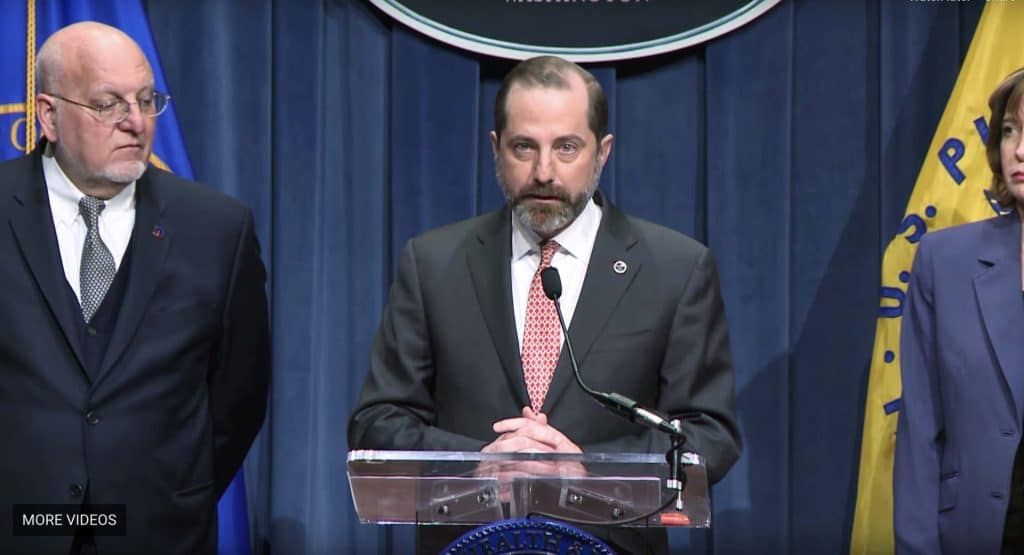The coronavirus outbreak: 3 ways the United States was (and is) unprepared
By Matt Field | February 11, 2020
 Alex Azar, the secretary of the Health and Human Services Department, at a recent press briefing on the coronavirus. Credit: Health and Human Services Department Twitter feed.
Alex Azar, the secretary of the Health and Human Services Department, at a recent press briefing on the coronavirus. Credit: Health and Human Services Department Twitter feed.
Much like the person who has already forgotten the pain of last week’s hangover and returns to the bar, the government tends to go back to its old ways after a crisis begins to ebb. The memory of the emergency fades. Plans, programs, and funding fall off the agenda. That’s a particularly unfortunate phenomenon when it comes to a public health crisis like the deadly coronavirus that’s spreading in China and has already made it to 24 other countries and a cruise ship, an emergency that is shining a spotlight on some of the ways the United States is unprepared for an epidemic.
In a wide-ranging discussion, Asha George, a biosecurity expert and executive director of the Bipartisan Commission on Biodefense and a member of the Bulletin’s Science and Security Board talked about where she thinks the government is falling short in its response to the coronavirus and other biological threats.
Funding for public health isn’t keeping up with the need. It’s hard to put a number on how much the US government should be spending on biodefense; various departments have programs that could fall under that broad umbrella. When it comes to public health preparedness efforts, however, like fighting the coronavirus, the funding isn’t enough. Last week, the Health and Human Services Department notified Congress that it may need to reallocate $136 million in funding to combat the disease, a sign of unmet need.
“They’re going to be robbing Peter to pay Paul in order to do this response,” George says. “I think we can say that. If the CDC (Centers for Disease Control and Prevention) itself is having to move more than $100 million to respond to something, and that’s just now, what happens when two more weeks goes by? They can’t continue to do that.”
Renewed funding of a government account that’s been around since the 1980s could help.
“We have had in the past a public health emergency response fund. And it was never really funded particularly well in the first place,” George says. “The Congress did say this is something that should be done. It just didn’t get a whole lot in the way of appropriations. Now, [the Bipartisan Commission on Biodefense] said that there needs to be $2 billion in that fund so that people can immediately draw from it and then replenish it later, instead of trying to respond and then belatedly going and asking Congress for an appropriation.”
One prominent congressperson, Connecticut Rep. Rosa DeLauro, issued a call for $5 billion to be placed in the Public Health Emergency Fund. She’d made the same request in 2016, during a Zika epidemic. At that time, according to her press release, the account had only been funded twice since it was set up in 1983. An NPR report from 2016 found that the fund had about $57,000 in it, down from $30 million when it was created. The government has other pots of money, and the Health and Human Services Department has been drawing money from an infectious disease response fund.
“I’m not saying that we’re that many billions of dollars short,” George says. “But if we had a whole lot of money, if the public health community were replete with dollars, I don’t think we would be talking about billions being put into a response fund.”
The Strategic National Stockpile isn’t sufficiently prepared to deal with emerging diseases like the coronavirus. The government maintains a stockpile of medicine, vaccines, and health supplies. There’s growing concern that some US supplies like masks and drug ingredients could be threatened. China, for example, makes a lot of the surgical masks that might play a part in slowing the spread of a disease like the coronavirus. But in addition to addressing threats to the supply chain, George says, the national stockpile needs to emphasize broader tools. Right now, a lot of what’s in the stockpile, George says, is there to combat narrow threats.
“As an example, people were worried about the threat of weaponized smallpox being used against the United States. So, what do we have in the stockpile? We have a whole bunch of smallpox vaccine,” she says. “Obviously, we had our anthrax events in 2001. So what do we have in the stockpile? We have a whole bunch of anthrax vaccines. It’s very specific things. Not to say we should just throw all that out, and that there’s no value in trying to have some targeted countermeasures for specific threats in there, but that stuff’s not going to do us any good when it comes time to dealing with coronavirus.”

The US has a biodefense strategy—it just isn’t following it. In 2018, the Trump administration released a National Biodefense Strategy which was supposed to help coordinate government-wide efforts like detecting and responding to diseases. George says the implementation of the strategy has fallen short of expectations.
“The implementation of a national strategy, it was slow to begin, and it was slow to continue,” she says. “And it’s our understanding that it sort of ground to a halt during the assessment phase.”
Both of Trump’s immediate predecessors, former presidents George W. Bush and Barack Obama, released broad strategies on biodefense, only to see them get bogged down in the implementation. In 2018, RAND researcher Daniel Gerstein chalked these failures up partly to lack of funding. None of the strategies, he wrote, “including the new Trump strategy, explicitly stated where the necessary resources would come from.”
Even a federal assessment of the Trump biodefense strategy is behind schedule. The GAO, a government agency that investigates the effectiveness of federal programs, announced last June it would release a comprehensive report by the end of 2019. A spokesperson said Friday that the report was now expected during the week of Feb. 17, because of the difficulty of working with “so many different federal agencies.”
The administration released the strategy in September 2018.
At the end of January, the Trump administration announced a coronavirus task force headed by Secretary of Health and Human Services Alex Azar. The announcement came a month after China reported cases of the new disease to the World Health Organization. George said that if the cabinet-level biodefense committee called for in the strategy were fully functional, then the administration wouldn’t have had to put together a specific coronavirus task force in the first place.
“We would have obviated the need for a coronavirus task force because The White House naturally would have said, ‘Well, we have steering committee, you guys just take it, it’s your thing.’”
Major disease outbreaks have been frequent in recent decades. After all, the 2014-2016 Ebola pandemic was only four years ago. The outbreaks of SARS, Zika, and the H1N1 flu, aren’t distant events either.
“We’re not talking about 5,000 mutations and 10, 20, 30 years before we’re dealing with a potentially horrible pandemic that kills millions and millions of people,” George says. “We’re maybe one or two mutations away from something like that. And I think we just need to do a better job taking that sort of risk into consideration.”
Read more Bulletin coverage on the Coronavirus outbreak here.
Together, we make the world safer.
The Bulletin elevates expert voices above the noise. But as an independent nonprofit organization, our operations depend on the support of readers like you. Help us continue to deliver quality journalism that holds leaders accountable. Your support of our work at any level is important. In return, we promise our coverage will be understandable, influential, vigilant, solution-oriented, and fair-minded. Together we can make a difference.















